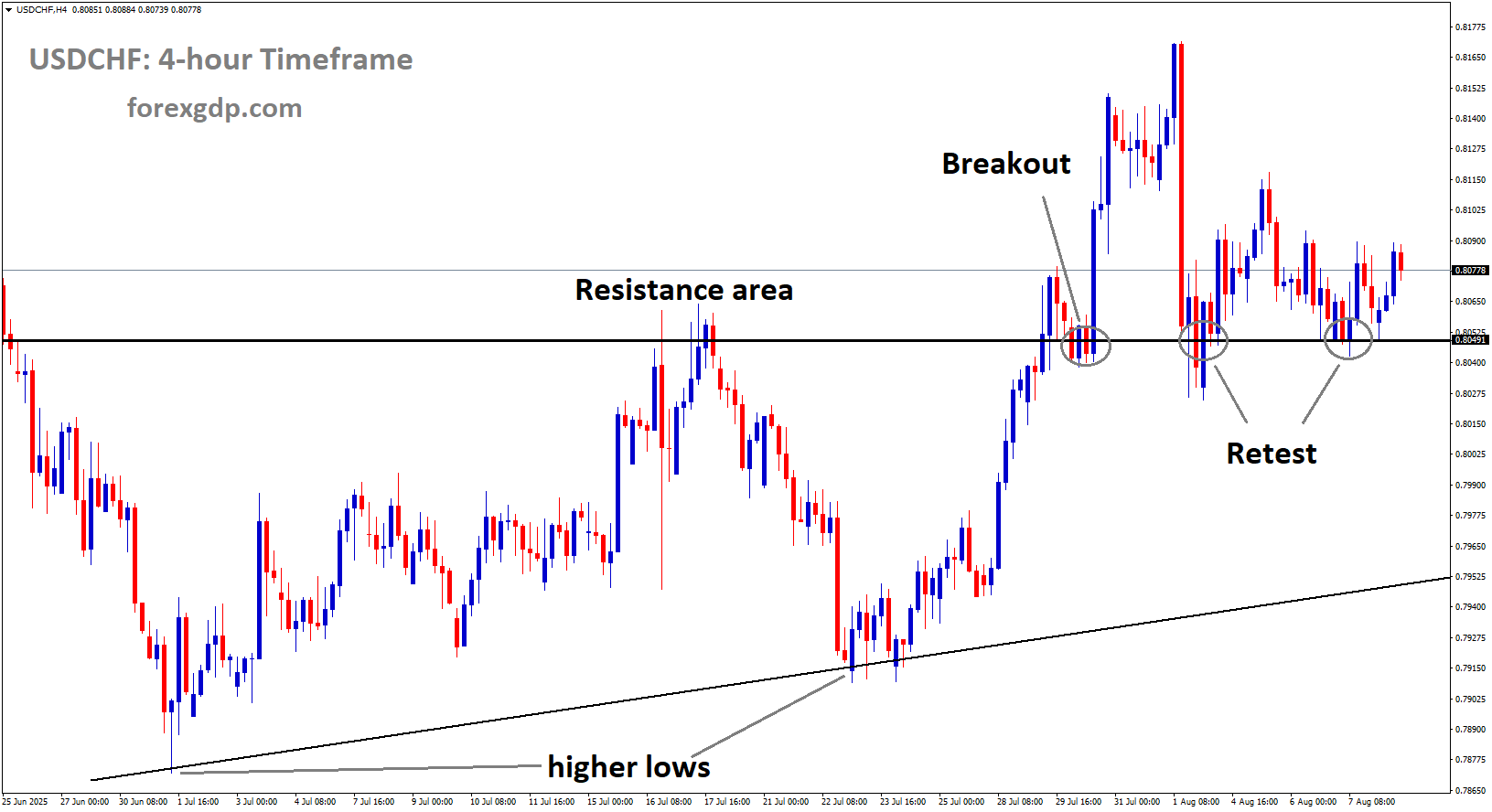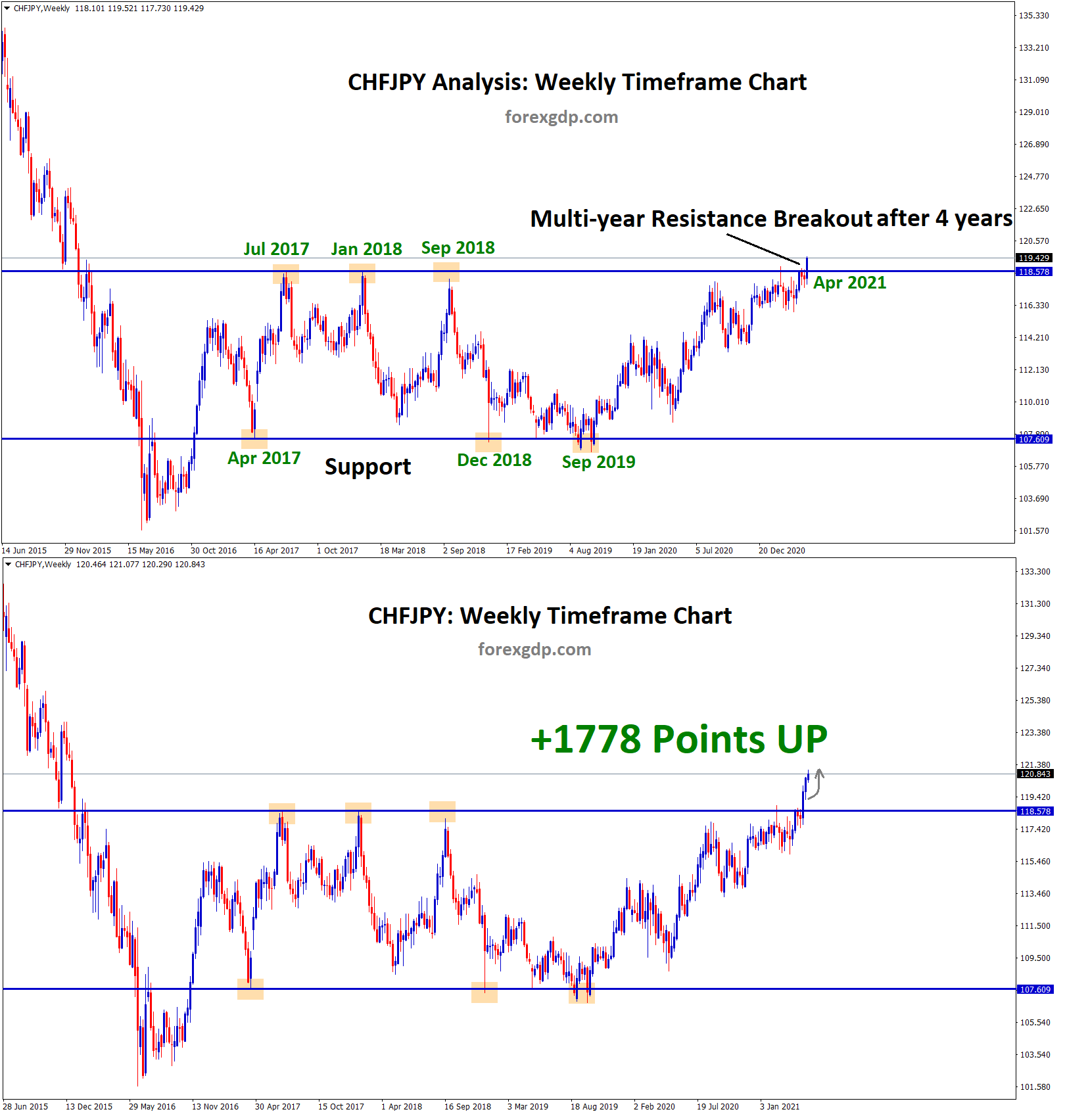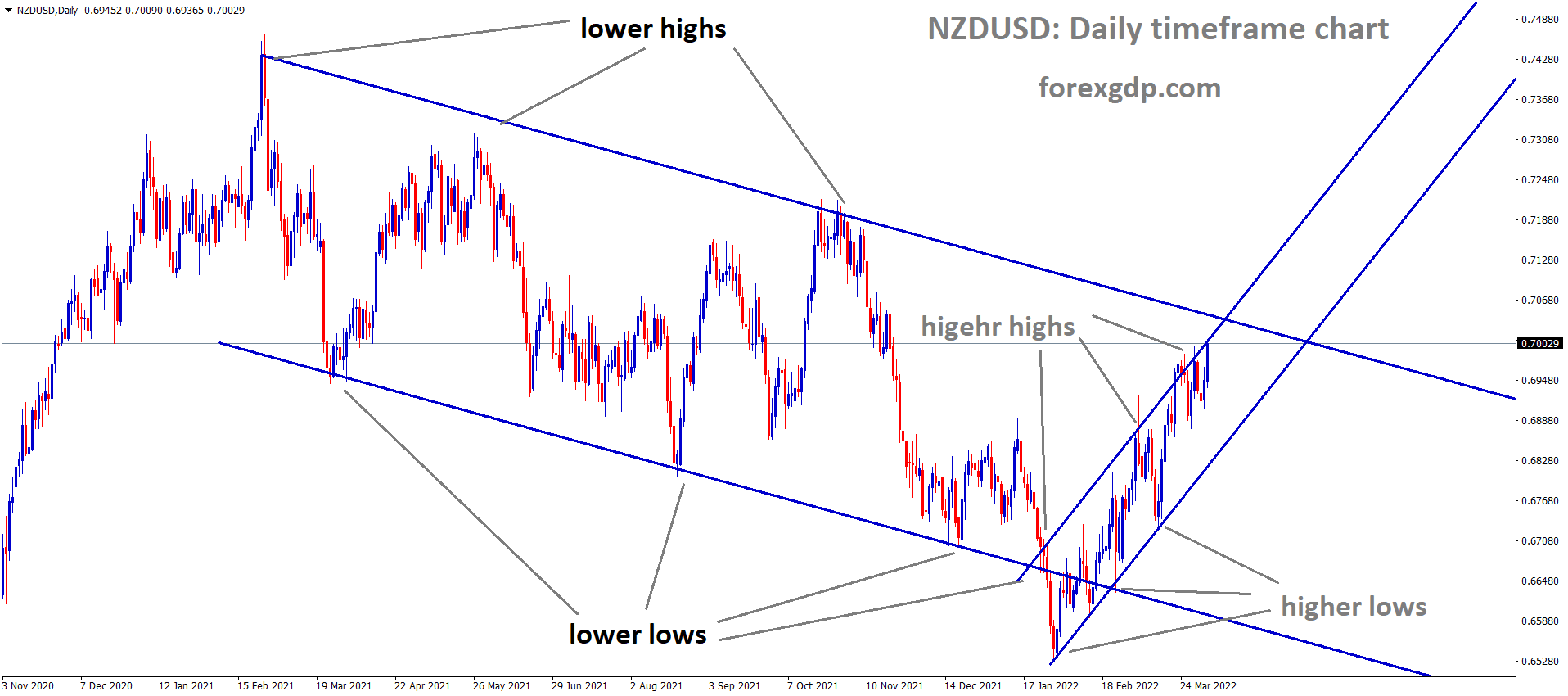USDCHF is rebounding from the retest area of the broken ascending triangle pattern
Daily Forex Trade Setups Aug 08, 2025
Stay on top of market trends with our Daily Forex Trade Setups (Aug 08, 2025)
USDCHF Stays Firm While Swiss Franc Struggles Under US Trade Pressure
When it comes to currency movements, there’s often more going on behind the scenes than just interest rates and economic growth. Right now, the USD/CHF pair is in an interesting position where several global and domestic factors are quietly shaping its next move. Let’s break down the situation in a way that’s easy to understand and follow.
Why the Swiss Franc is Under Pressure
One of the biggest developments impacting the Swiss Franc at the moment is the United States’ decision to impose a 39% tariff on imports from Switzerland. This is not a minor change – it’s a hefty charge that makes Swiss goods significantly more expensive in the U.S. market.
Switzerland relies heavily on its exports, and the U.S. is one of its biggest trading partners. When such a large tariff comes into play, it can hurt Swiss businesses, reduce the demand for Swiss goods, and ultimately weaken the country’s currency.
The Swiss government hasn’t been passive about this. President Karin Keller-Sutter and Economics Minister Guy Parmelin even flew to Washington to present a revised trade proposal. Unfortunately, no agreement was reached, and the tariff remains in place. This leaves Swiss exporters facing higher costs and reduced competitiveness in a key market.
The Swiss National Bank’s Role
The Swiss National Bank (SNB) is known for its proactive monetary policy, and it hasn’t ruled out pushing interest rates further into negative territory. Why would they do that?
The answer lies in inflation – or rather, the lack of it. Swiss inflation in July was just 0.2%, which is slightly above expectations but still far below the levels most central banks aim for. In economic terms, that’s practically zero inflation, and it suggests that prices are barely moving.
When inflation is this low, central banks often try to stimulate spending and investment by lowering interest rates. Negative rates, while unusual in many countries, are not new for Switzerland. If the SNB does cut rates further, it would likely reduce the appeal of holding Swiss Francs, pushing the currency lower.
What’s Happening in the U.S.
On the other side of the USD/CHF equation is the U.S. dollar, and here the story is a little different. The U.S. labor market is showing signs of cooling down. Recent job data indicates that more people are filing for unemployment benefits, and hiring is slowing compared to previous months.
To put numbers on it, new unemployment claims rose to 226,000 for the week ending August 2, which is higher than both the market expectation and the previous week’s figure. This followed a July Nonfarm Payrolls report that also pointed to a softer labor market.

Why does this matter for the currency? Because a weaker labor market makes it more likely that the Federal Reserve will cut interest rates. In fact, market expectations for a September rate cut have jumped dramatically – from around 48% just a week ago to roughly 93% now. There’s even talk of another cut in December.
Lower U.S. interest rates typically make the dollar less attractive. However, in the case of USD/CHF, the situation is a bit more balanced because the Swiss side of the equation is also dealing with its own pressures.
How These Factors Play Together
When you look at these developments side by side, it’s clear that both currencies are facing potential headwinds:
-
Swiss Franc: Pressured by U.S. tariffs, weak inflation, and the possibility of deeper negative interest rates from the SNB.
-
U.S. Dollar: Facing downward pressure from a cooling labor market and the rising likelihood of Fed rate cuts.
However, the tariff issue in Switzerland is particularly significant because it directly impacts the country’s trade and economic outlook. This may tip the balance in favor of the U.S. dollar in the short to medium term, potentially giving USD/CHF room to strengthen.

USDCHF is moving in a box pattern, and the market has reached the support area of the pattern
Why Traders Are Watching Closely
Currency traders and investors are closely monitoring developments on both sides. For the Swiss Franc, the big question is whether the SNB will actually take the plunge and cut rates further into negative territory. For the U.S., all eyes are on upcoming economic data and Federal Reserve commentary to see if the September rate cut becomes a done deal.
While the USD/CHF exchange rate has remained steady for a couple of days, the underlying forces suggest potential for movement in the near future. If the Swiss side continues to face economic and trade-related pressure while the U.S. situation doesn’t deteriorate dramatically, the pair could trend upward.
Final Summary
The USD/CHF currency pair is sitting at the intersection of two very different economic stories. In Switzerland, heavy U.S. tariffs, low inflation, and possible negative interest rate cuts are weighing on the Franc. In the U.S., a softer job market is fueling expectations of interest rate cuts by the Federal Reserve.
Although both currencies have reasons to weaken, the Swiss Franc’s challenges appear more immediate and potentially more severe. Unless the trade tensions ease or Swiss inflation picks up meaningfully, the U.S. dollar could have the upper hand, leading to a gradual strengthening of USD/CHF in the coming weeks.
EURUSD Slips as Markets Focus on Who Will Lead the Fed Next
The currency markets have been buzzing lately, and one of the hottest topics has been the Euro losing some steam while the US Dollar makes a modest comeback. At first glance, it might seem like just another day in the trading world, but when you look closer, there’s a whole mix of political developments, central bank speculation, and economic data shaping this move. Let’s break it all down in a simple and engaging way so you can follow along without getting lost in complicated financial jargon.
A New Fed Chair on the Horizon? Why It Matters
One of the biggest reasons behind the Dollar’s recent strength comes down to speculation over who might be the next head of the US Federal Reserve. Jerome Powell’s term as Fed Chair isn’t going to last forever, and the name that’s suddenly making headlines is Christopher Waller.
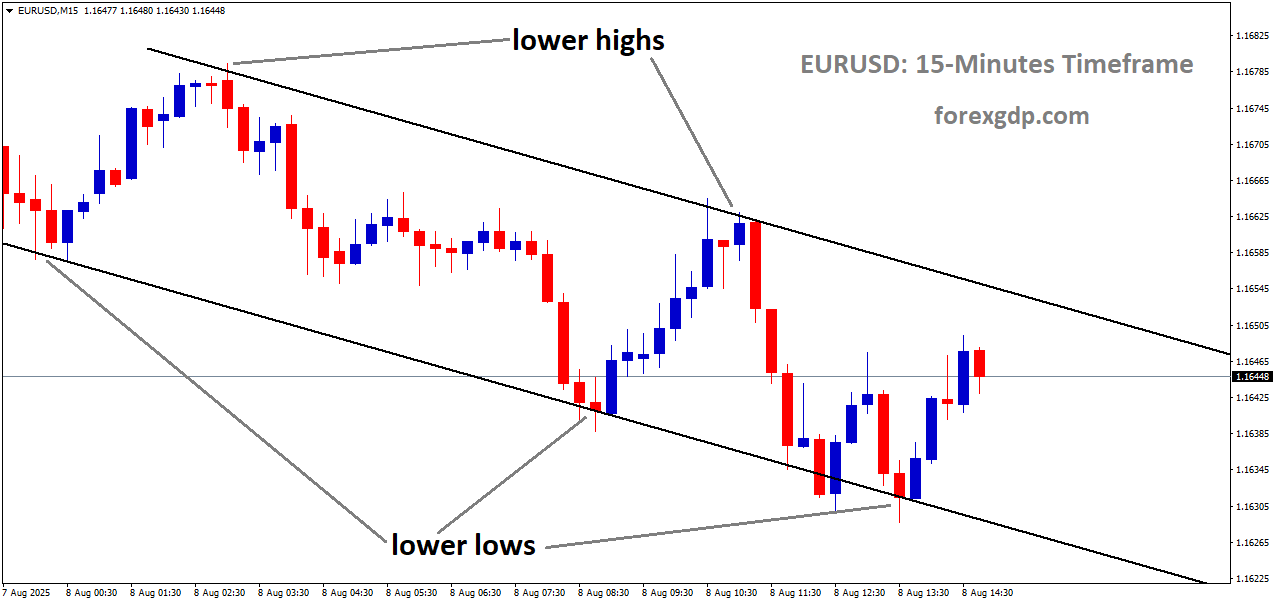
EURUSD is moving in a descending channel, and the market has rebounded from the lower low area of the channel
According to reports, members of former President Donald Trump’s team had a positive meeting with Waller—though he hasn’t actually met Trump himself yet. Waller is already a familiar figure in the financial world, known for his views on keeping interest rates lower, but he’s also widely respected. That balance means his potential appointment is unlikely to shake the Fed’s credibility, which is an important factor for investors.
Alongside Waller’s name, there’s also talk of Stephen Miran joining the central bank’s board. While his position would be temporary, he would still have voting power in several key upcoming meetings. Analysts believe his presence could align with Trump’s preference for a looser monetary policy, which tends to support economic growth but can also influence inflation.
Economic Data Adds Another Layer to the Story
The speculation over leadership isn’t the only thing affecting the markets right now. Some fresh US economic data is also playing a role in shaping the Dollar’s movements.
Rising jobless claims — New figures show that more Americans filed for unemployment benefits than expected last week. This could be a sign that the labor market, which has been strong for a long time, is starting to cool off. A softer job market often increases pressure on the Fed to cut interest rates in order to stimulate growth.
Productivity and labor costs — Another set of numbers released this week revealed that US productivity grew at a slower pace than forecast, while labor costs came in slightly higher than expected. This combination paints a mixed picture—sluggish productivity can worry policymakers, but moderate labor costs help keep inflation from spiraling out of control.
On top of this, Atlanta Fed President Raphael Bostic took a cautious tone, suggesting that while he’s watching the labor market closely, it’s too early to promise a September rate cut. His comments also included a warning about how tariffs could add to inflation pressures—something that’s always on the Fed’s radar.
Global Politics Sneak Into the Currency Game
While most people think of exchange rates as purely financial, global politics often play a hidden role. A recent example is the news that Donald Trump plans to meet Russian President Vladimir Putin. This has sparked speculation that there could be progress toward a peace agreement in Ukraine.

For the Euro, any sign of de-escalation in the region is seen as positive. The war has had huge economic and energy-related consequences for Europe, so even the smallest hope of resolution can give the currency a short-term boost. That said, political headlines like this can shift quickly, so traders tend to react cautiously.
Market Sentiment: Still Walking a Fine Line
Even though the US Dollar has managed to pick itself up from recent lows, investors aren’t rushing in with large positions just yet. There’s still a lot of uncertainty—both about the Fed’s leadership and about how the central bank will respond to economic data in the coming months.
Short-term movements in currencies often come down to small bursts of news or data, but the bigger trends depend on a mix of political stability, economic health, and central bank strategy. Right now, all three of those areas are in a state of transition, which makes the markets particularly sensitive to new information.
Key Factors Traders Are Watching Now
-
Who will lead the Fed? The choice between different candidates could signal either a more aggressive or more cautious approach to rate cuts.
-
Labor market strength — If jobless claims keep rising, it could tip the Fed toward more stimulus sooner rather than later.
-
Global stability — Any steps toward peace in Ukraine could change the Euro’s outlook dramatically.
-
Tariffs and inflation — The balance between protecting industries and keeping prices in check is tricky, and it directly impacts interest rate decisions.
What’s Next for the Euro and Dollar?
With Friday’s calendar relatively light, attention is turning toward upcoming speeches and meetings from key Fed officials. One notable event is a speech from St. Louis Fed President Alberto Mussalem, which could give a hint about the central bank’s short-term thinking.
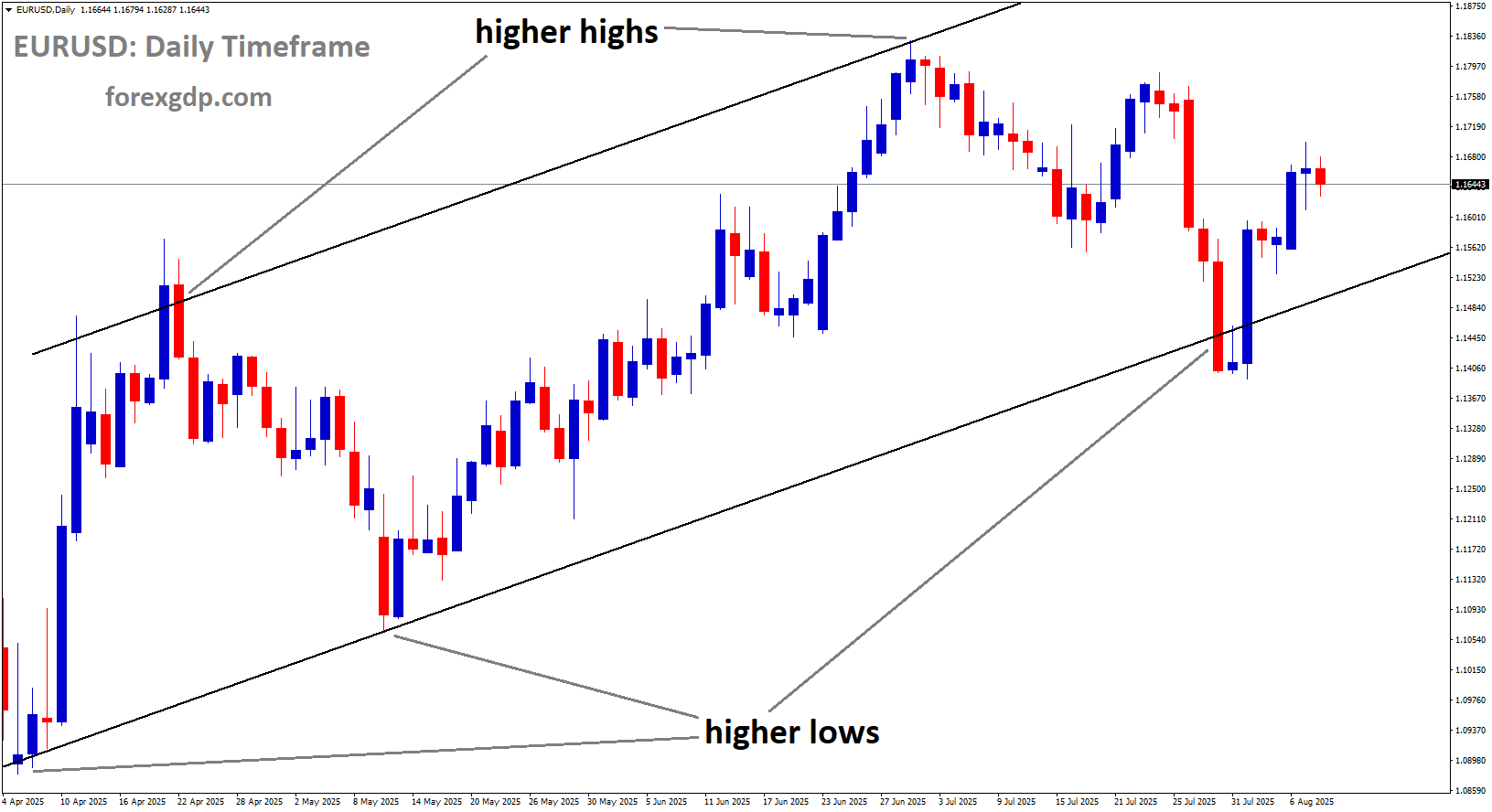
EURUSD is moving in an Ascending channel, and the market has rebounded from the higher low area of the channel
In the days ahead, expect the conversation to keep revolving around the Fed’s future leadership and the next interest rate move. The combination of political decisions, economic indicators, and unexpected world events means the road ahead for both the Euro and the Dollar will likely be full of twists.
Final Summary
The Euro’s recent slip and the Dollar’s bounce aren’t just random market noise—they’re the result of a complicated mix of political rumors, economic signals, and global developments. Talk of Christopher Waller stepping into the Fed Chair role, alongside Stephen Miran’s possible short-term influence, has stirred speculation about the direction of US monetary policy. At the same time, jobless claims and productivity data hint at a shifting economic landscape that could pressure the Fed into action.
Add in the geopolitical backdrop of a potential Trump-Putin meeting, and it’s clear why traders are reacting so carefully. For now, the Dollar is showing signs of strength, but the real story will unfold over the coming weeks as leadership choices and economic trends become clearer.
If you’re following the markets, this is one of those times where staying alert to headlines—both political and economic—could make all the difference. The moves we’re seeing now might just be the early chapters in a much bigger story for both currencies.
USDJPY Extends Gains as Risk Appetite Drains Demand for Yen
The Japanese Yen has recently been under selling pressure, with market sentiment shifting in ways that have created a complex trading environment. While some central bank commentary suggests the potential for higher interest rates in Japan later this year, other factors are pulling in the opposite direction, creating uncertainty for traders and investors.
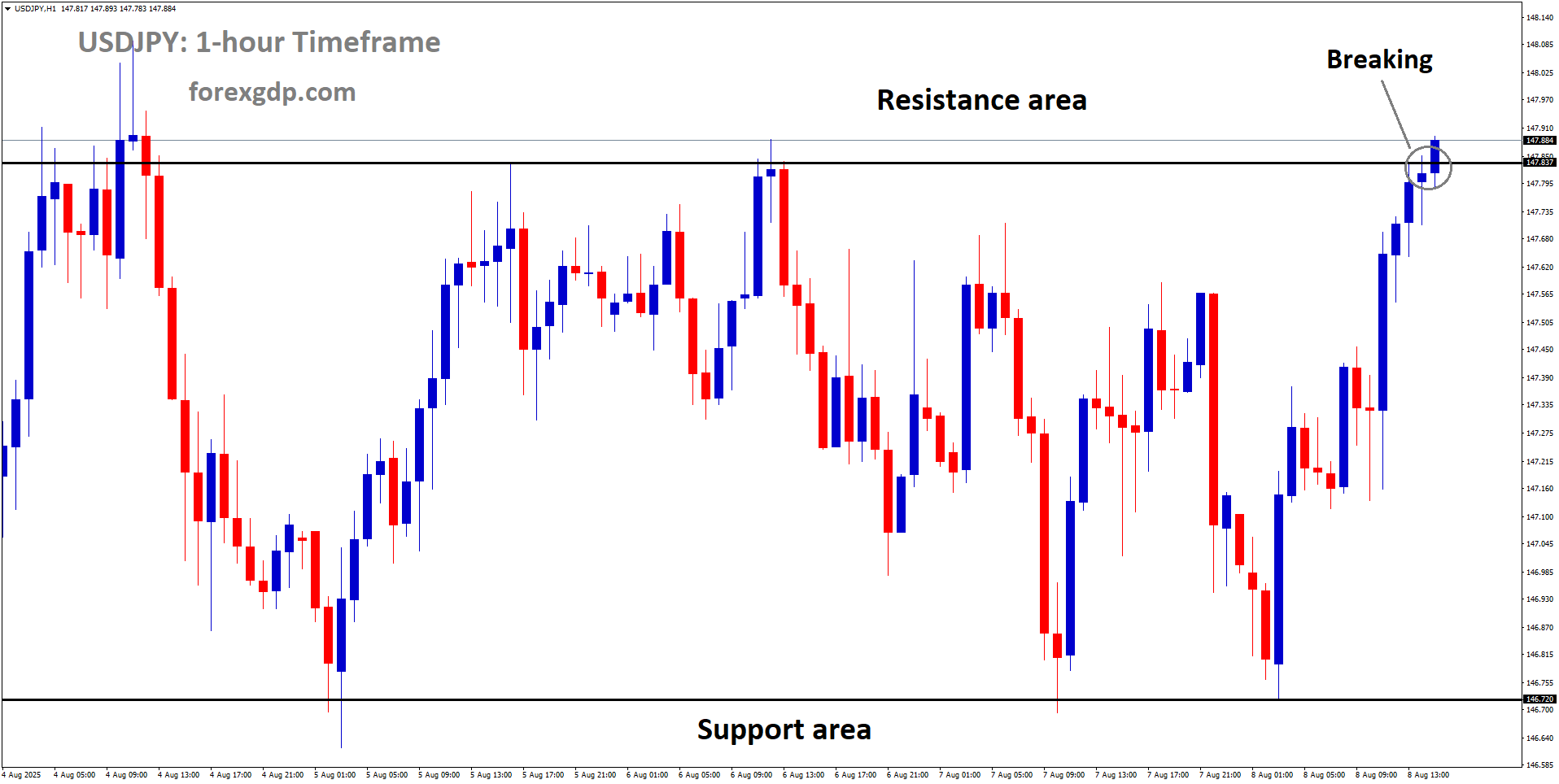
USDJPY is breaking the resistance area of the box pattern
Let’s break down what’s happening with the Yen, why risk appetite is affecting its movement, and how developments in both Japan and the US are shaping the USD/JPY dynamics.
A New Wave of Yen Selling in the Asian Session
During the latest Asian session, the Japanese Yen weakened against the US Dollar, fueled by a fresh wave of selling. One of the main triggers was the Summary of Opinions from the Bank of Japan’s late-July meeting. While the central bank hinted at the possibility of raising rates before the year ends, it also acknowledged challenges that could delay such moves.
The uncertainty largely revolves around the impact of US tariffs and broader economic risks. In addition, safe-haven demand for the Yen has eased, with global markets leaning towards a more optimistic tone. When risk sentiment is positive, investors typically move out of safe-haven assets like the Yen and into higher-yielding investments.
The combination of these factors — reduced demand for safe assets and subtle shifts in central bank policy expectations — opened the door for the USD/JPY pair to bounce back from its recent low.
Bank of Japan’s Balancing Act
The Bank of Japan (BoJ) is facing a tricky situation. On one hand, it’s signaling that higher interest rates could be on the horizon — potentially by the end of the year. On the other hand, recent economic data suggests the Japanese economy may not be strong enough to handle aggressive tightening.
Sluggish Growth Outlook
The BoJ’s summary revealed that policymakers expect Japan’s economic growth to slow in the coming months. Inflation progress is also expected to be sluggish, at least temporarily. These projections don’t paint a picture of an economy ready for rapid monetary tightening.
Weak Consumer Spending
Adding to the challenge, Japan’s household spending data for June showed a steep monthly decline, the worst since early 2021. High living costs appear to be discouraging consumer spending, which is a vital driver of the economy. This weaker consumption trend could make it harder for the BoJ to justify hiking rates soon, even if inflation is a concern.

Stock Market Boost Dampens Yen Demand
Interestingly, while economic data has been mixed, Japanese equities have been performing strongly. The Topix index crossed the 3000 mark for the first time ever, and the Nikkei 225 also surged. Strong stock performance often attracts foreign investment, which can boost capital inflows but reduce demand for the Yen as a safe haven.
The US Dollar’s Role in the Story
While the Yen has been dealing with domestic pressures, developments in the US have also been influencing the USD/JPY pair.
Fed Rate Cut Expectations
There’s growing belief that the Federal Reserve could start cutting interest rates as soon as September. If that happens, it would narrow the interest rate gap between the US and Japan, potentially giving the Yen some support. For now, though, the US Dollar has enjoyed a modest rebound, helped by occasional bursts of buying interest.
Signs of a Cooling US Job Market
US labor data released recently showed higher-than-expected jobless claims, indicating potential cracks in the labor market. While this supports the case for Fed rate cuts, it also means the Dollar’s upward momentum may be limited.
Political Influence Over the Fed
Another interesting development is the political angle. The US President has nominated a new candidate to fill a Federal Reserve Governor’s seat and is considering replacements for the Fed Chair role. Such moves could raise questions about the Fed’s independence, which may influence how markets view the Dollar in the months ahead.
Why This Matters for USD/JPY Traders
The current USD/JPY landscape is shaped by two opposing forces:
-
BoJ’s Possible Rate Hike – which would typically strengthen the Yen.
-
Fed’s Potential Rate Cuts – which would usually weaken the Dollar.
But it’s not that simple. Positive risk sentiment, strong stock market performance, and political uncertainties are blurring the picture. The result is a market where neither side has a clear advantage, making short-term movements unpredictable.

USDJPY is moving in a descending triangle pattern
At the same time, traders are watching for any fresh clues from central bank speeches, as these could quickly tilt sentiment in one direction or the other. With no major US economic data scheduled for immediate release, speeches from key Federal Open Market Committee (FOMC) members could be the main driver heading into the weekend.
Final Summary
The Japanese Yen’s recent weakness reflects a mix of global risk appetite, central bank policy uncertainty, and shifting economic data in both Japan and the US. While the BoJ has hinted at the possibility of a rate hike later this year, weaker consumer spending and slowing growth expectations make that path uncertain. On the other hand, the US Dollar faces its own challenges, with markets increasingly betting on a Fed rate cut in September.
In this environment, USD/JPY traders are left navigating a landscape where economic fundamentals, political developments, and investor sentiment are all pulling in different directions. For now, the market remains sensitive to central bank signals and shifts in global risk sentiment — meaning the story of the Yen is far from over.
AUD/USD Continues Uptrend on Renewed Global Optimism
The Australian Dollar has been enjoying a strong run lately, with its value climbing steadily over the past week. Investors have been flocking to the currency, encouraged by upbeat economic signals from Australia’s key trading partner, China. At the same time, weakness in the US Dollar is giving the Aussie an extra push, making it one of the better-performing currencies in recent days.
Let’s break down what’s happening and why the Australian Dollar is standing out in the global market right now.
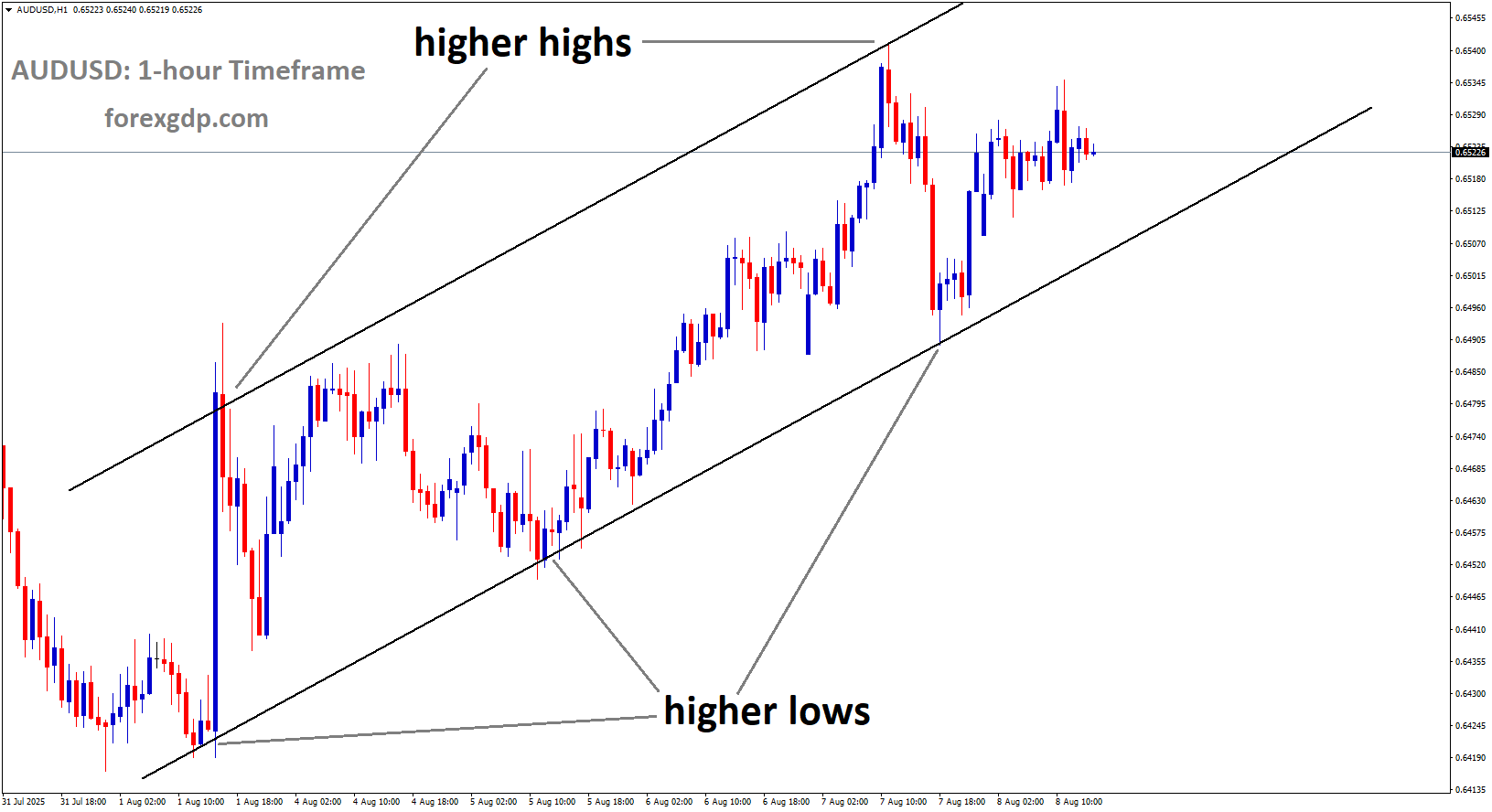
AUDUSD is moving in an Ascending channel
Aussie Dollar Rides a Wave of Positive Sentiment
The Australian Dollar has been moving higher for four straight days, and this week it’s heading towards a notable weekly gain. The overall market mood has been on the brighter side, giving traders the confidence to take on more risk — and the Aussie often benefits when that happens.
One of the main reasons for this lift is fresh, positive trade data from China. Since China is Australia’s largest export market, anything that boosts China’s economic outlook tends to support the Australian Dollar as well.
China’s Strong Export Growth Supports the Aussie
Exports Point to Economic Strength
Earlier this week, China reported surprisingly strong export numbers for July. Exports rose by 8% compared to the same month last year, an improvement from June’s already solid growth. The country’s trade surplus also widened significantly, showing that its goods are in high demand around the world.
This kind of performance is important for a few reasons. First, it signals that China’s manufacturing and trade sectors are holding up well despite past challenges, such as global economic uncertainty and international trade tensions. Second, it reinforces the idea that China’s economy might continue to grow steadily, which bodes well for Australia’s resource-heavy export industry.
Why This Matters for Australia
Australia exports a range of goods to China, from minerals and energy products to agricultural commodities. When China’s economy is thriving, it tends to buy more from Australia, boosting demand for the Australian Dollar. That’s exactly what we’re seeing now — traders are betting on stronger trade flows between the two countries, and they’re positioning themselves accordingly.
US Dollar Struggles to Gain Ground
While the Aussie has been climbing, the US Dollar has been stuck near its recent lows. Several factors are weighing it down, and this weakness is helping to make the Australian Dollar even more attractive by comparison.

Fed Uncertainty Creates Caution
One key reason for the US Dollar’s softer tone is uncertainty surrounding the Federal Reserve. There’s ongoing speculation about changes in leadership at the central bank, with talk of new appointments to replace some current members. This is making traders hesitant to place big bets on the US Dollar until there’s more clarity.
Signs of a Softer US Job Market
Fresh economic data from the US is also contributing to the cautious mood. Jobless claims — the number of people applying for unemployment benefits — rose more than expected last week. This adds to growing evidence that the US labor market is losing momentum, which could influence the Fed’s future interest rate decisions.
Many investors believe the Fed could cut interest rates in the coming months to support the economy. Lower rates typically make a currency less appealing to investors, which is part of the reason why the US Dollar has been struggling.
Market Expectations and What’s Next
Right now, markets are pricing in a strong chance of the Federal Reserve easing monetary policy after the summer. While some Fed officials have tried to temper these expectations, the overall sentiment still leans towards potential rate cuts ahead.
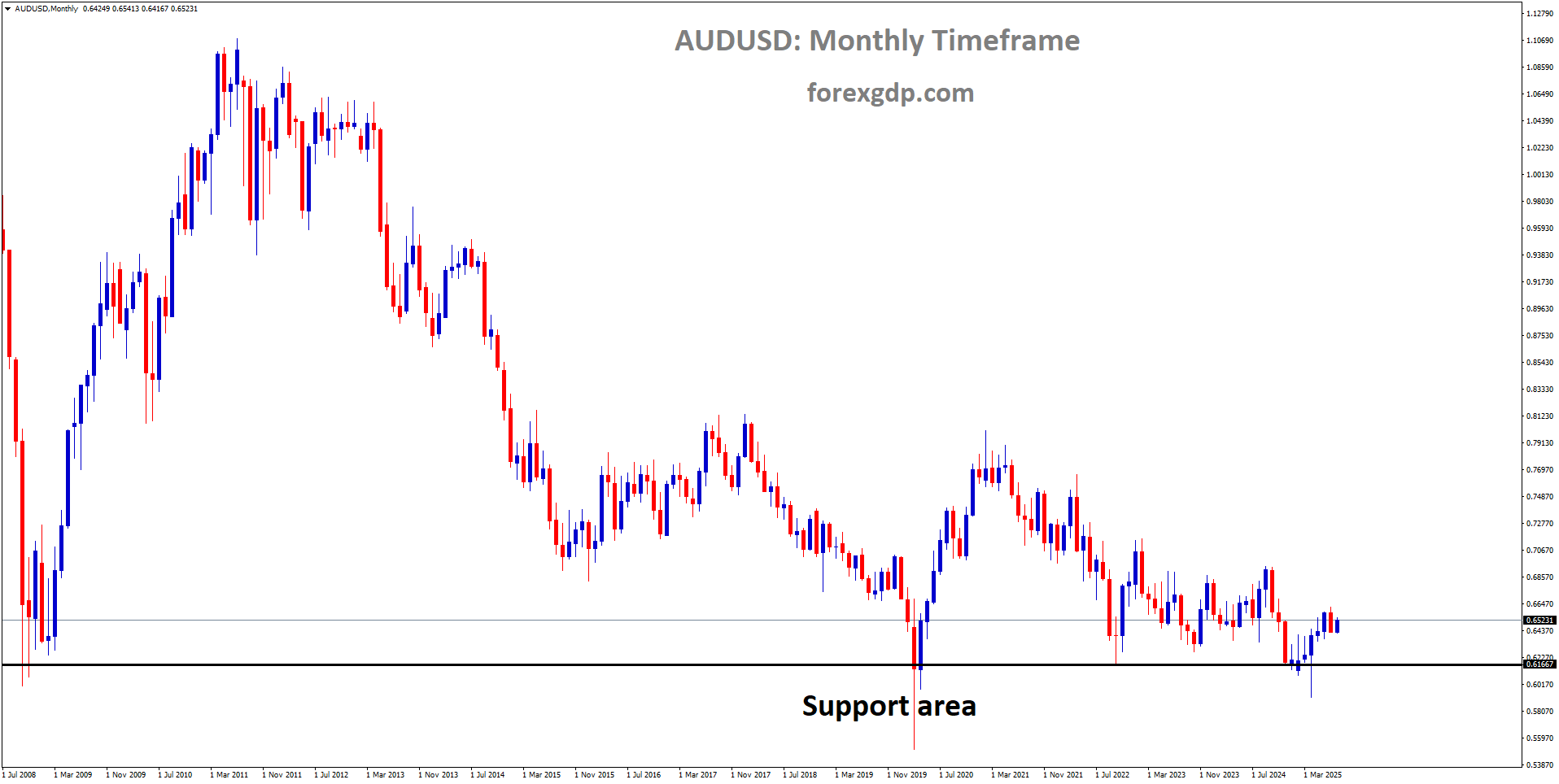
AUDUSD is rebounding from a major support area
If the Fed does decide to lower rates, it would likely put more pressure on the US Dollar. That could allow the Australian Dollar to extend its recent gains, especially if global market sentiment remains positive and China continues to deliver encouraging economic data.
Final Summary
The Australian Dollar is enjoying a strong run thanks to a combination of upbeat market mood, robust Chinese export growth, and ongoing weakness in the US Dollar. China’s latest trade figures have boosted confidence in the region’s economic outlook, while uncertainty around the Federal Reserve’s next moves is keeping the US Dollar on the back foot.
For now, the balance of factors seems to favor the Aussie. If China maintains its economic strength and the Fed leans towards cutting rates, the Australian Dollar could remain in demand in the weeks ahead. This combination of supportive fundamentals and positive sentiment is what’s making the Aussie stand out in the currency market right now.
NZDUSD Strengthens on Growing Hopes for Fed Rate Cuts
The New Zealand Dollar (NZD) has been holding its ground against the US Dollar (USD) recently, with the NZD/USD pair enjoying a steady climb. This move has been supported by strong economic signals from both New Zealand and its key trading partner, China. However, traders are still keeping a cautious eye on certain challenges that could affect the currency’s momentum in the weeks ahead.
Let’s dive deeper into what’s driving this rally, what’s holding it back, and how global economic factors are influencing the pair.

NZDUSD is moving in an uptrend channel
Why the NZD/USD Has Been Climbing
Several factors have fueled the recent upward push in the NZD/USD pair.
China’s Strong Trade Performance
One of the biggest drivers has been China’s stronger-than-expected trade surplus. China remains New Zealand’s largest trading partner, so any improvement in Chinese trade activity can directly benefit the Kiwi dollar. Recently, China’s trade surplus expanded significantly, signaling healthy export demand and resilient global trade flows despite a challenging economic environment.
For New Zealand, this is welcome news. A healthy Chinese economy often translates to stronger demand for New Zealand’s agricultural exports, dairy products, and raw materials. This link is a major reason why positive data from China tends to give the NZD an immediate boost.
RBNZ’s Inflation Expectations
The Reserve Bank of New Zealand (RBNZ) also played a role in supporting the currency. While inflation expectations have eased slightly, the fact that the central bank remains vigilant on inflation adds confidence to the market. A controlled inflation outlook can help maintain stability and keep the NZD attractive to investors, particularly in a global environment where interest rate movements are closely watched.
Improved Risk Sentiment
Global risk sentiment has also improved in recent days. When traders feel optimistic about the broader economy, they tend to move toward higher-yielding currencies like the NZD. With markets expecting interest rate cuts from the US Federal Reserve later this year, the appeal of the Kiwi has grown even more.
The Challenges on the Horizon
While the recent rally is encouraging, it’s not all smooth sailing for the NZD/USD. There are headwinds that could slow or reverse its progress.
New Tariffs from the US
A major concern for New Zealand’s export sector is the newly imposed 15% tariff on its exports to the US. This policy change took effect recently and could hit New Zealand’s trade earnings if it remains in place for an extended period. Since New Zealand relies heavily on international trade, such tariffs could weigh on the economy and, by extension, the NZD.

Lingering Global Uncertainty
Even though China’s trade performance has been strong, other parts of the global economy remain uncertain. Slower growth in some regions, geopolitical tensions, and fluctuating commodity prices all have the potential to create volatility for the Kiwi dollar. Any unexpected negative developments could quickly dampen investor enthusiasm.
The Fed’s Role in Shaping the Outlook
The US Federal Reserve’s policy direction is playing a big role in shaping NZD/USD movements right now.
Expectations for Rate Cuts
Markets are currently pricing in a high probability of a rate cut from the Fed in September, with another possible cut before the end of the year. This shift in expectations has been fueled by softer US labor market data, including an increase in jobless claims and signs of cooling in the nonfarm payroll numbers.
When the Fed cuts rates, it tends to weaken the US Dollar, making other currencies like the NZD more attractive. This is why traders are closely watching every economic release from the US for confirmation that rate cuts are on the way.
Labor Market Signals
Recent US jobless claims data showed a noticeable uptick in people applying for unemployment benefits. This comes on the heels of a softer-than-expected jobs report, reinforcing the belief that the US labor market is losing some steam. A weaker labor market gives the Fed more reason to lower interest rates, which could extend the NZD/USD rally.
What Traders Should Watch Next
Upcoming Chinese Data
In the immediate future, traders will be watching for the latest consumer and producer price data from China. If inflation numbers show stability or improvement, it could further boost confidence in China’s economic strength and indirectly support the NZD.
RBNZ Policy Moves
The Reserve Bank of New Zealand’s next steps will also be closely monitored. While inflation expectations have eased, any signs that the RBNZ is leaning toward a more cautious or hawkish stance could influence the currency’s trajectory.

NZDUSD is moving in a descending channel
US Economic Releases
From the US side, upcoming reports on inflation, retail sales, and manufacturing will be critical in shaping market expectations for the Fed’s September meeting. A continued slowdown in the data could solidify the case for rate cuts, which would likely favor the NZD.
Final Summary
The NZD/USD has been riding a wave of positive momentum, thanks to strong Chinese trade figures, improving investor sentiment, and rising expectations for US interest rate cuts. However, the currency pair isn’t without its challenges. The newly introduced US tariffs on New Zealand exports and lingering uncertainties in the global economy could put the brakes on further gains.
For now, traders are balancing optimism with caution. The next few weeks will be shaped by key data releases from China, New Zealand, and the US, along with any policy shifts from the RBNZ and the Fed. If the economic numbers continue to support a softer US Dollar and a stable New Zealand outlook, the NZD/USD could maintain its upward path. But with global markets always prone to sudden shifts, staying informed and adaptable will be the key to navigating the road ahead.

